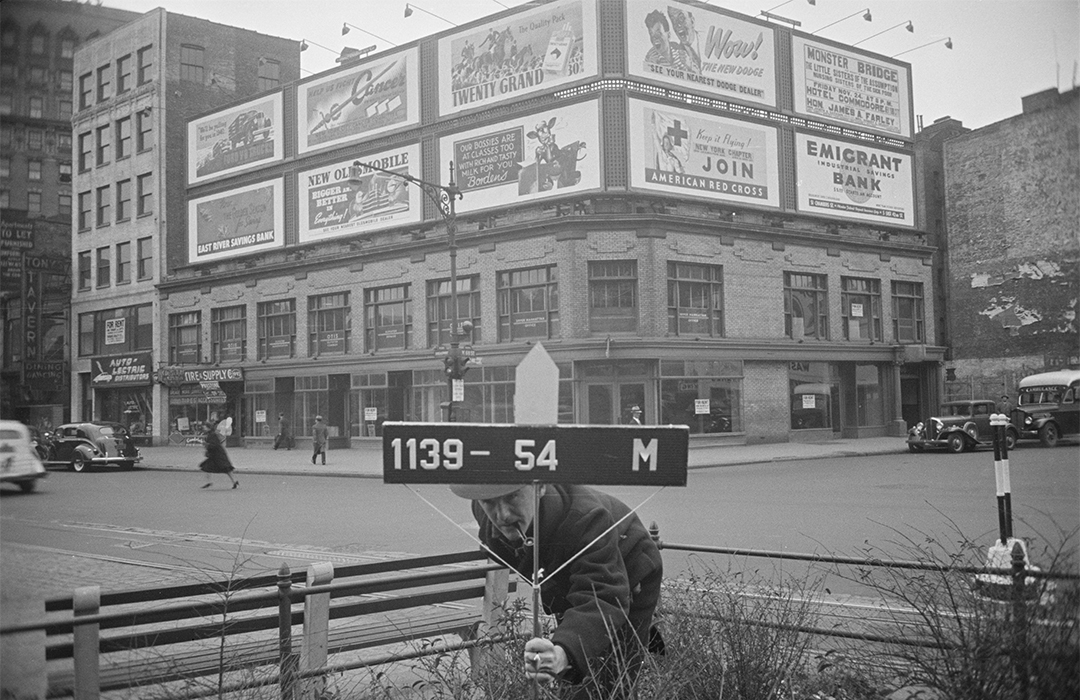
The Armory Building – 1993-1999 Broadway
by Tom Miller
On March 20, 1908, architect Clarence L. Sefert filed plans for a two-story “taxpayer” to be erected by John J. Downer at the southwest corner of Broadway and 68th Street. (A taxpayer was a low-rise building that brought in enough rent to cover the real estate taxes and was normally relatively temporary.) Completed within the year, his Arts & Crafts style structure featured commercial space on the ground floor and a large meeting room on the second. Sefert gave the upper-level variations on the modern Chicago-style windows and used brick to create raised decorative panels.
The lower section was more glass than masonry–the vast show windows necessary for Downer’s initial tenant, the W. M. P. Motor Company. Broadway above Times Square was known as “Automobile Row” because of the glut of automotive-related businesses along the thoroughfare. In the company’s showroom here, potential customers browsed among vehicles like the 1910 Abbott-Detroit “Thirty,” which sold for $1,500 (about $47,700 in 2024), or the even more expensive C. G. V. Town Car, that retailed for $2,750.
Broadway above Times Square was known as “Automobile Row” because of the glut of automotive-related businesses along the thoroughfare.
The upper floor was leased to the Professional Woman’s League. The group tackled civic and social issues, hosted lectures and plays, and gave entertainment. On November 9, 1912, for instance, The Evening Post reported, “Miss Villa Faulkner Page will speak on ‘The Advantage of Being You’ to-morrow at 3:30, at her regular Sunday afternoon service at the Professional Woman’s League, No. 1999 Broadway (entrance on Sixty-eighth Street).” And on February 26, 1913, The Evening Post reported, “Prominent stage people and others equally well known in the literary, art, and civic circles of the city, will contribute to the programme [sic] of the Woman’s Progressive League at its birthday entertainment Friday night.”
In 1915 the Bryant Sales Company took over half of the ground floor, selling Goodyear tires and performing automobile maintenance. The other half was occupied by the Fellsen Tire Company, Inc.
When America entered World War I in 1917, the Professional Woman’s League turned its attention to the conflict. On February 10, 1918, The New York Sun reported that the group would be giving “a series of twelve entertainments at the club rooms, 1999 Broadway, for the purpose of raising funds for an ambulance to be given to Sergeant Daniel McGinnis, Second Canadian Battalion.” This would be the second vehicle the women’s group donated. The article noted, “Word has been received by the league that the kitchen trailer recently purchased by the members and sent over has been safely landed in France.”
The building underwent a remodeling in 1926 by architect Herbert J. Krapp.
In July 1921, J. D. Sugarman & Co. moved into part of the second story as a branch of its headquarters on Beaver Street. The brokerage firm also published Sugarman’s Weekly Market Indicator. In announcing the opening of the uptown office, the firm stressed, “You are invited to inspect these offices. Phone at any time for latest market news and quotations.”
The building underwent a remodeling in 1926 by architect Herbert J. Krapp. The changes resulted in stores along the ground floor and a “dance hall and stores” on the second. That changed in 1958 when the second floor was converted to offices.
In 1964 the 1993-1999 Broadway was sold and quickly razed to make way for an 18-story mixed use building completed in 1974.
Tom Miller is a social historian and blogger at daytoninmanhattan.blogspot.com
BUILDING DATABASE
Keep Exploring
Be a part of history!
Think Local First to support the business at 1995 Broadway:


